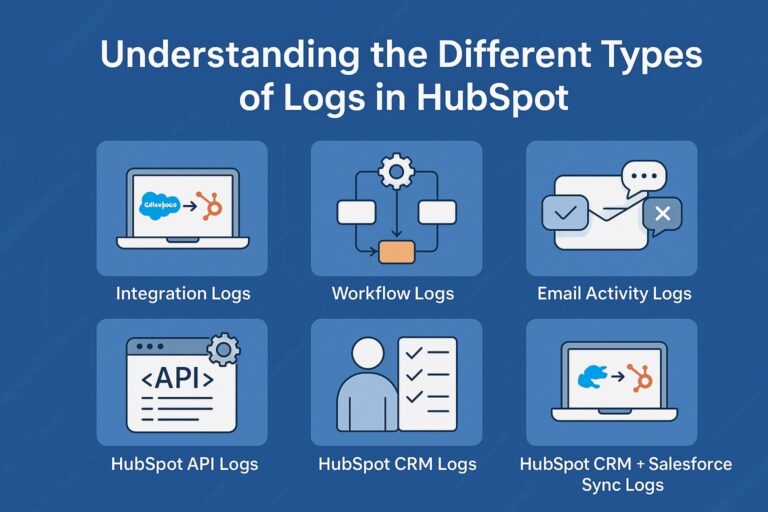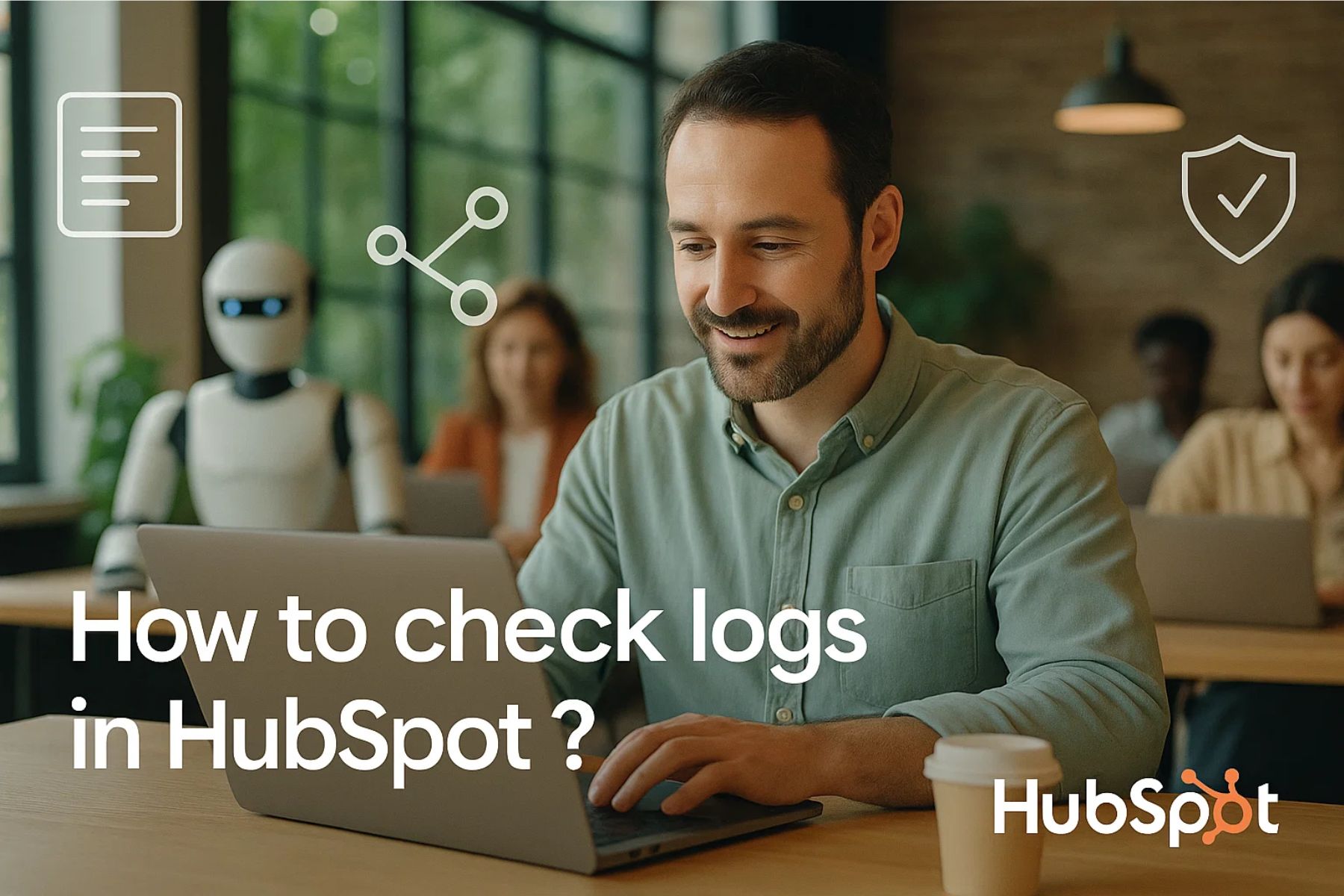How to Check Logs in HubSpot?
If you’ve ever wondered how to check logs in HubSpot, you’re not alone. Whether you’re managing integrations, troubleshooting sync errors, or conducting a HubSpot Audit (learn more here), understanding where to find and interpret logs is crucial.
Logs give you visibility into data syncs, workflows, email sends, API calls, and Salesforce CRM connections helping your sales and marketing teams avoid costly errors and maintain operational transparency.
Why Checking Logs in HubSpot Matters
In real-world business scenarios, logs often make or break your CRM efficiency.
Example:
A marketing manager notices leads from a landing page aren’t showing in the CRM. Without checking the logs, it’s nearly impossible to tell if it’s due to a form error, API issue, or workflow misfire.
By checking logs in HubSpot, you can:
-
Identify failed integrations or sync errors instantly.
-
Audit user activities and workflows for compliance.
-
Debug API requests and webhooks efficiently.
-
Prevent lost leads or duplicate records before they disrupt reporting.
Understanding the Different Types of Logs in HubSpot
HubSpot provides multiple log categories depending on your plan and setup. Let’s break them down:
1. Integration Logs
Integration logs record the communication between HubSpot and connected platforms like Salesforce, Shopify, or Xero.
Where to find them:
-
Navigate to Settings → Integrations → Connected Apps.
-
Select the integration (e.g., Salesforce).
-
Click View Logs to see sync status, error messages, and timestamps.
Real Example:
A sales team using HubSpot CRM + Salesforce noticed missing deal updates. By checking Salesforce Sync Logs, they identified an outdated field mapping that caused sync failures.
2. Workflow Logs
Workflow logs track automation actions—like email sends, property updates, or list enrollments.
To view workflow logs:
-
Go to Automation → Workflows.
-
Open a specific workflow.
-
Click the History or Execution Log tab.
Here, you can monitor:
-
Which contacts were enrolled or skipped.
-
Errors or delays in action execution.
-
Whether API calls or custom code failed.
Scenario Example:
A marketing automation specialist finds that nurture emails stopped mid-sequence. In the workflow log, they spot a “Failed Action” caused by missing contact permissions.
3. Email Activity Logs
For teams managing campaigns, email logs help verify delivery performance.
Steps to access email logs:
-
Go to Marketing → Email → Sent.
-
Click on a specific email campaign.
-
View Recipients, Bounces, Unsubscribes, or Spam Reports.
Useful for:
Marketing teams tracking deliverability issues, such as domain misconfiguration or bounced leads from specific segments.
4. HubSpot API Logs
When you’re dealing with integrations or custom apps, API logs are your best friend.
How to check logs in HubSpot API:
-
Go to your HubSpot Developer Account.
-
Click Monitoring → API Calls.
-
View details such as endpoint accessed, response codes, and timestamps.
You can filter by:
Real Use Case:
A SaaS company using HubSpot APIs for lead import found that 30% of POST requests failed due to a throttling limit. Reviewing the API logs allowed their dev team to optimize request intervals.
5. HubSpot CRM Logs
The CRM logs track user and system activities related to contacts, deals, and pipelines.
To access CRM activity logs:
-
Go to Settings → Account Setup → Audit Logs (Enterprise plan only).
-
Choose Users and Teams to track login, modification, or export history.
-
Filter logs by user, object type, or date.
Scenario Example:
A sales manager discovered missing deal records. The audit logs revealed that a team member accidentally deleted the records during bulk updates.
6. HubSpot CRM + Salesforce Sync Logs
If you use the HubSpot-Salesforce connector, the Sync Health dashboard becomes critical.
To check HubSpot CRM + Salesforce logs:
-
Navigate to Settings → Integrations → Connected Apps → Salesforce.
-
Select Sync Errors or Field Mappings.
-
Use filters to identify data type mismatches or permission-based rejections.
Common Errors Found:
Example:
A financial services firm noticed discrepancies in opportunity stages. By reviewing HubSpot CRM + Salesforce sync logs, they corrected mapping errors that caused inconsistent pipeline updates.

How to Interpret HubSpot Log Errors
Understanding error types helps you fix issues faster. Here’s what they mean:
| Error Type |
Meaning |
Common Fix |
| 401 Unauthorized |
Invalid API key or OAuth token |
Regenerate the key or reconnect the app |
| 404 Not Found |
Incorrect endpoint or missing record |
Check API URL or record ID |
| 429 Too Many Requests |
Rate limit exceeded |
Add delay or batch requests |
| 500 Internal Error |
Server-side issue |
Retry later or contact HubSpot Support |
| 400 Bad Request |
Invalid JSON or field value |
Validate request format |
How Logs Support a HubSpot Audit
Performing a HubSpot Integration Audit means reviewing every aspect of your CRM setup—from integrations and data hygiene to workflows and user access. Logs form the foundation of this audit.
By combining log insights with your audit strategy, you can:
-
Detect automation inefficiencies.
-
Ensure data integrity between systems.
-
Identify users with excessive or risky access.
-
Improve cross-platform integrations.
Learn more about conducting a HubSpot Audit here.
Best Practices for Managing HubSpot Logs
-
Review Logs Weekly:
Regular monitoring helps detect sync errors early.
-
Export Logs Monthly:
Create backups or share with your IT/security teams.
-
Use Alerts:
Enable notifications for workflow or integration failures.
-
Document Resolutions:
Maintain an internal wiki of common log errors and fixes.
-
Leverage APIs:
Use HubSpot API endpoints to pull logs programmatically for advanced monitoring.
Common Real-Life Problems Solved Through Log Checks
-
Problem: Leads not appearing in CRM.
Log Insight: Form submission API error due to missing consent property.
Solution: Update form configuration and reprocess submissions.
-
Problem: Workflows skipped actions.
Log Insight: Enrollment criteria changed; contacts no longer qualified.
Solution: Adjust filters and re-enroll affected contacts.
-
Problem: Sales data not syncing with Salesforce.
Log Insight: Salesforce API authentication expired.
Solution: Reconnect integration using a valid token.
-
Problem: Email open rates dropped suddenly.
Log Insight: SMTP configuration error logged in email settings.
Solution: Fix DNS records and retry send.
Conclusion
Learning how to check logs in HubSpot is essential for maintaining data consistency, troubleshooting integration issues, and ensuring operational transparency. Whether you’re working with HubSpot API logs, CRM activity logs, or Salesforce sync logs, regular log monitoring can prevent small issues from escalating into CRM-wide failures.
For businesses seeking expert guidance, Mpire Solutions offers professional HubSpot Api Audit and integration support to help you manage, monitor, and optimize your HubSpot ecosystem effectively.
FAQs
1. How do I check API logs in HubSpot?
Go to your HubSpot Developer Account → Monitoring → API Calls. You’ll see all requests, responses, and errors for each connected app.
2. Can I see who deleted a record in HubSpot CRM?
Yes, under Settings → Account Setup → Audit Logs, Enterprise users can track deletions and user actions across objects.
3. How can I check Salesforce sync logs in HubSpot?
Visit Settings → Integrations → Connected Apps → Salesforce, then open Sync Errors to identify and resolve issues.
4. Are email logs available for marketing emails?
Yes. Go to Marketing → Email → Sent, select a campaign, and view metrics such as bounces and spam reports.
5. How often should I check HubSpot logs?
Ideally, logs should be checked weekly for workflows and daily for integrations—especially when using APIs or connected CRMs.
Relevant Guide
How to Use n8n Discount Code – Step-by-Step Guide for 2025
How Long to Do Website Migration? HubSpot Website Migration Guide
What is Revenue Operations? Explained with Roles & HubSpot Impact
What is n8n Chatbot? Guide to WhatsApp & AI Chat Automation (2025)
HubSpot and Deltek Integration
Amplemarket and HubSpot Integration
Hire n8n experts
 HubSpot Consulting Needs
HubSpot Consulting Needs  Custom Automation Plan
Custom Automation Plan 






